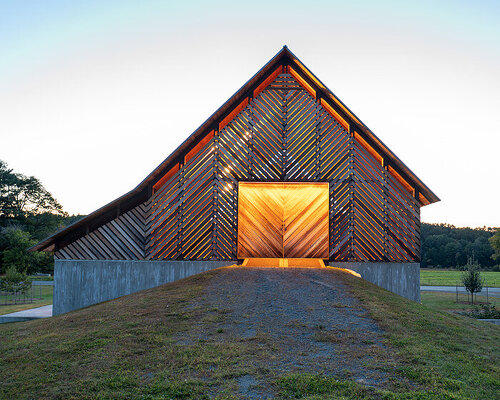a new england barn reconsidered
Sylvia Richards Practice for Architecture takes to the quiet clarity of the open fields of Lyme, New Hampshire to build a luminous barn. From a distance, the timber building appears rooted in regional vernacular, echoing the silhouette and scale of traditional New England barns. Yet as one approaches, familiar forms begin to shift. The texture of the facade breathes; light moves freely through the upper structure. the architect’s approach channels both historical awareness and architectural experimentation.
Sylvia Richards drew inspiration from the utilitarian intelligence of older barns in the region, where uncured wooden boards once allowed air to pass between interior and exterior. This built-in ventilation system, born from necessity, finds a contemporary counterpart in Lyme Barn’s porous upper facade. Rather than replicate a typology, the architect reactivates a centuries-old strategy, treating airflow as both a functional and spatial medium.
images © Timothy Downing
A Contemporary Frame by sylvia richards
With the design of its Lyme Barn, architect Sylvia Richards responds to stringent local conservation requirements. Situated on a seventy-acre parcel held within the Upper Valley Land Trust, the design had to preserve both visual and functional ties to agriculture. Richard replaced a dilapidated structure with a new barn that adheres to its intended purpose while embracing a more complex programmatic arrangement. Vehicles rest on the ground floor, while farming equipment is stored above, reversing the logic of a historic barn’s layout.
Sylvia Richards addressed the barn’s inverted load by anchoring the building in mass timber. This choice reinterprets traditional post-and-beam framing with a material palette more in tune with today’s sustainability standards. Below, folding glass doors open toward the southern light, while a steel-and-wood panel system creates visual weight to the north. The balance between exposure and enclosure is deliberate, establishing a sectional dialogue between heaviness and lift.
the Lyme Barn reinterprets New England barn architecture through light and materiality
Elevated Material Weaving in lyme
On the upper level of Lyme Barn, Sylvia Richards introduces what she calls a ‘straw hat’ construction. Diagonal cedar boards float over bronze mesh, forming a patterned veil that filters light and air. The rhythm of this woven skin, combined with a careful structural layering, gives the space its defining character. Interior light moves with the grain of the materials, animating the volume across day and night.
The ceiling plane is treated as a stage for quiet variation. On the north side of the nave, irregular skylights scatter daylight onto the interior. To the south, a suspended constellation of globe pendants hangs from a concealed roof deck, casting low glows downward. Sylvia Richards preserves the porous lower edge of the south wall, allowing subtle glimpses between levels, and drawing a visual line from the upper room to the garage porch below.
the design draws from historic use of green wood siding to create a breathable and porous facade
The Barn becomes something beyond its practical brief when viewed from within. The architecture gathers and reshapes light with sensitivity, turning what might have been a utilitarian enclosure into an almost devotional space. Through its quiet modulation of sunlight and shadow, the building achieves an unexpected calm, informed by its agricultural context.
Without invoking historical mimicry, Sylvia Richards threads the project into the longer architectural lineage of spaces shaped by light. The project draws comparisons through atmosphere. Silvia Richards notes inspiration from the luminous interiors of Le Corbusier’s Ronchamp or the sculpted skylights of Tadao Ando. With these precedents in mind, the architect seeks to captures light in a way that slows time.
the project was built on a conservation site that required agricultural use and visual continuity
Sylvia Richard inverted traditional barn functions, placing equipment above and vehicles below
a mass timber frame supports the structure and updates post and beam construction for sustainability
the upper level features diagonally spaced cedar boards over bronze mesh that filter light and air
a ribbon of translucent glass separates the two floors, creating a floating lantern effect
project info:
name: Lyme Barn
architect: Sylvia Richards Practice for Architecture | @sylviarichardsarchitecture
location: Lyme, New Hampshire
area: 4,000 square feet
photography: © Timothy Downing / Design & Co.
principal, project designer: Sylvia Richards
consulting architect: Christopher Smith
engineer: Florian Beck PE, Bensonwood
construction: Geoffrey Little, Lyme, NH
mass timber structural system: Bensonwood
production and supply of mass timbers: Bensonwood, Nordic Structures
The post sylvia richard-designed lyme barn glows like a patterned lantern in new england appeared first on designboom | architecture & design magazine.

